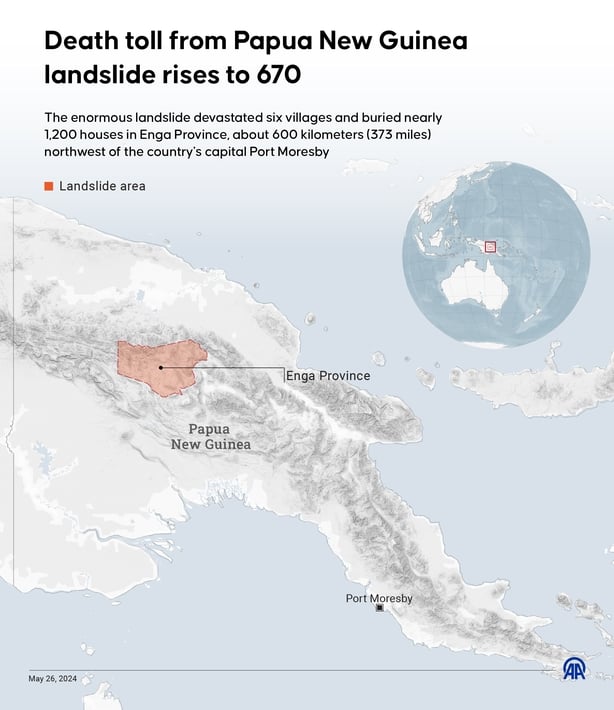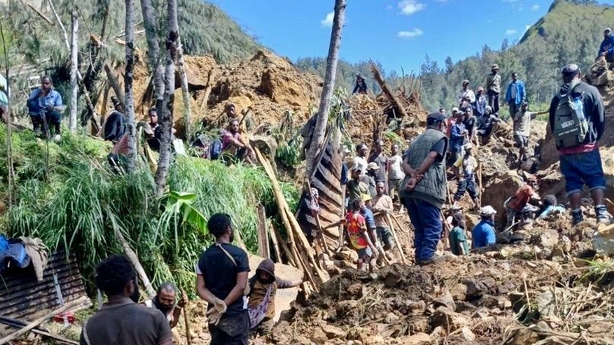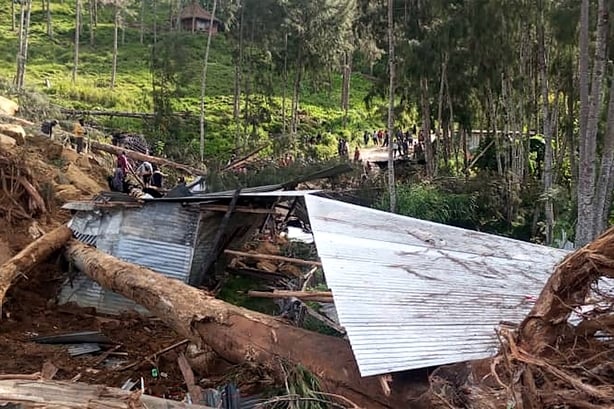Papua New Guinea's massive landslide three days ago buried more than 2,000 people, the government has said, as treacherous terrain and difficulties transporting aid lowered hopes of finding survivors.
The National Disaster Centre gave the new number in a letter to the UN released today but dated yesterday.
A separate UN agency put the possible death toll at more than 670 people.
The variance reflects the remote site and the difficulty getting an accurate population estimate. The Pacigic island nation's last credible census was in 2000 and many people live in isolated mountainous villages.
The country's defence minister Billy Joseph said 4,000 people had been living in the six remote villages in the Maip-Mulitaka area in Enga province, where the landslide occurred in the early hours of Friday while most were asleep.
The landslide crashed through six villages in the Maip-Mulitaka district in the country's north at around 3am on Friday while most of the community slept.
More than 150 houses were buried beneath debris almost two stories high. Rescuers told local media they heard screams from beneath the earth.
"I have 18 of my family members being buried under the debris and soil that I am standing on, and a lot more family members in the village I cannot count," resident Evit Kambu told Reuters.
"But I cannot retrieve the bodies so I am standing here helplessly."
More than 72 hours after the landslide, residents are still using spades, sticks and their bare hands to try and shift the debris and reach any survivors.
Only five bodies had been found, according to the provincial authority.
Woman loses 18 relatives in landslide
Aid trickle
Villagers held a funeral, as mourners walked behind the coffin weeping, according to the UN official's video.
Heavy equipment and aid have been slow to arrive due to the remote location while tribal warfare nearby has forced aid workers to travel in convoys escorted by soldiers and return to the provincial capital, roughly 60 kilometres away, at night.
Eight people were killed and 30 houses burnt down on Saturday, a UN agency official said. Aid convoys today passed the still smoking remains of houses.
The first excavator only reached the site late yesterday, according to a UN official.
Many people are still unsure whether loved ones were in the path of the landslide because villagers often move between the homes of friends and relatives, according to Matthew Hewitt Tapus, a pastor based in Port Moresby whose home village is roughly 20 kilometres from the disaster zone.
"It's not like everyone is in the same house at the same time, so you have fathers who don't know where their children are, mothers who don't know where husbands are, it's chaotic," he told Reuters by phone.

Mr Joseph said the defence operations chief was sent to the disaster scene within 24 hours, with assistance from the Australian Defence Force, and a PNG defence engineering team was on site, as well as a military helicopter for evacuations.
The government has requested a New Zealand Defence Force geotechnical team to assess possibly unstable land nearby which would making heavy earth-moving equipment dangerous, he said.
The province needs to build capacity for disaster warnings, the minister added, saying the government would rebuild the villages and reopen the main highway to the town and gold mine at Porgera.
Prime Minister James Marape's office said the disaster was being handled by Papua New Guinea emergency authorities and Mr Marape was in the capital Port Moresby preparing for the return of parliament tomorrow, where he faces a no-confidence motion.
Australia announced an initial A$2.5 million (€2.3m) aid package and said it would send technical experts to help rescue and recovery. The Australian Defence Force is already providing logistical support.

China, which has been wooing Pacific island nations, said it would heed the needs of Papua New Guinea and provide assistance within China's capabilities for disaster relief and post-disaster reconstruction.
"We believe that the people of Papua New Guinea will be able to overcome difficulties and rebuild their homeland at an early date," foreign ministry spokesperson Mao Ning said at a daily news briefing when asked about aid to Papua New Guinea.
The government has requested a New Zealand Defence Force geotechnical team to assess possibly unstable land nearby which would making heavy earth-moving equipment dangerous, he said.
The province needs to build capacity for disaster warnings, the minister added, saying the government would rebuild the villages and reopen the main highway to the town and gold mine at Porgera.

Site still dangerous
Even when rescue teams can get to the site, rain, unstable ground and flowing water is making it extremely dangerous for residents and rescue teams to clear debris, according to Serhan Aktoprak, the chief of the UN migration agency's mission in Papua New Guinea.
There is still a risk the soil and debris could shift again and more than 250 homes have been abandoned as officials encourage people to evacuate, he said. More than 1,250 people have been displaced.
Some local residents also do not want heavy machinery and excavators entering the village and interrupting the mourning, he said.
"At this point, people I think are realising that the chances are very slim that anyone can basically be taken out alive," he said.


